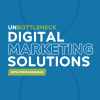What Percentage of People Click on the First Search Result?
There are plenty of reports you can run to determine your website’s current position in any search engine, and many of the newer reporting services offer you traffic data for the exact keyword you might be tracking. However, there are very few tools to help you estimate exactly how many visitors you could receive if your webpage were in the top position; assuming it is not already.
Knowing the average CTR rate of the 1st position may help you estimate traffic and conversions if you know how to segment selling versus topic queries.
Using a combination of Google Search Console (GSC) and Google Analytics (prior to the recent encrypted search change), and after manually verifying top positions for specific terms, I was able to capture what percentage of people clicked on the first search result in Google, the search engine with the greatest market share.
10% to 18% Click on First Search Result
The webpages I measured varied in category, and the keywords I selected could absolutely be considered competitive in nature. View the table below for a full breakdown of the data used to get the 10% to 18% conclusion. As it turns out 10% represents actual visits, where 18% is what Google reported in GSC as Clicks.
Click the image below to enlarge to enlarge the table and reveal several other columns, including Visit-Through Rate or VTR (the percentage people who actually make it through to the page) and difference between Google’s CTR info and VTR – ergo the 10% to 18% range.
You’ll also see my version of organic Impression Share, which makes the Google Keyword Planner data questionable based on Exact Match query data matched to actual visits. Not to mention the fact that Google chose to not provide data for two of my most important keywords, both are highlighted (fascinating, right?).
Important Bias and Non-Bias Factors
Every URL above had titles and meta descriptions that were written by hand with title tag principles in mind. That is, they each include a strong call-to-action, the focus keyword, and a unique selling proposition. We also borrowed copy from top-performing AdWords ads in many of the titles and meta descriptions.
A small handful of the listings included some form of rich snippet, including a video thumbnail (Schema.org/VideoObject) and organic site links. Therefore, you may have higher than average CTR’s on a sample of the test list, which is normal for any search engine optimization specialist, the target reader of this study.
None of the keywords analyzed include a brand name.
However, it’s important to note that the majority of keyword traffic across all accounts came from keywords that did include a brand name. None of the accounts were primarily keyword centric; they were all established brands.
Also, every keyword had a buyer behavioral intent.
For example, the term “what is SEO” would be a topic, or informational search, where a term I often optimize for, “SEO expert”, is a phrase where the user is likely searching for a person or service.
Why This Study Was an Eye-Opener for Me
From the GSC data I learned that most non-brand high-traffic keywords were actually not in the top position. This was the same across all six very different industries.
The data I pulled with average position came from GSC, though a few search terms I manually monitored via proxy for a period of 60 days to insure data accuracy. No scraping tools were used whatsoever.
What does this mean? It’s possible that non-brand keywords have a significant fluctuation in rank and that we as SEO’s may be too focused on a single term we’ll never really be able to control.
Working instead at a landing page level to include related and semantic search terms in the copy and from within varied anchors in internal links, we can squeeze more juice out of long-tail search terms, but ultimately it’s the brand and brand modified keywords that we can control and should be focused on.
In other words, we should use our offline and other advertising efforts to encourage users to search for our brand name accompanied by keywords we’d like to receive traffic from. Example: “Use your favorite Internet search tool to look for ABC Company widget manufacturing” or “Find us in Google under widget manufacturing ABC Company”.
As our brand increases in relevancy for these modifiers, the search engines seem to amalgamate our brand with the keywords (similar to the “SEO Expert” example above when you analyze the number of occurrences of my name before and after the query in quotes).
What to Do with This CTR Number
So now that you have an average range to reference, which number should you use? For me, I plan on using a number somewhere in the middle as to not be too conservative or too ambitious. I’m going to use 14%. Which means if I were going to estimate traffic and conversions from a set of buying intent keywords, it might look something like this (assuming I have AOV and conversion data):
Keep in mind, that this style of estimating does not include semantic derivatives or related keywords that you might include within context on the landing page associated with the long-tail keyword.
What are You Seeing in Your Google Search Consule?
I’d love to know if you are seeing the same range of CTR after reviewing your own GSC on competitive search terms. Please share below to see how close my numbers are to yours.
